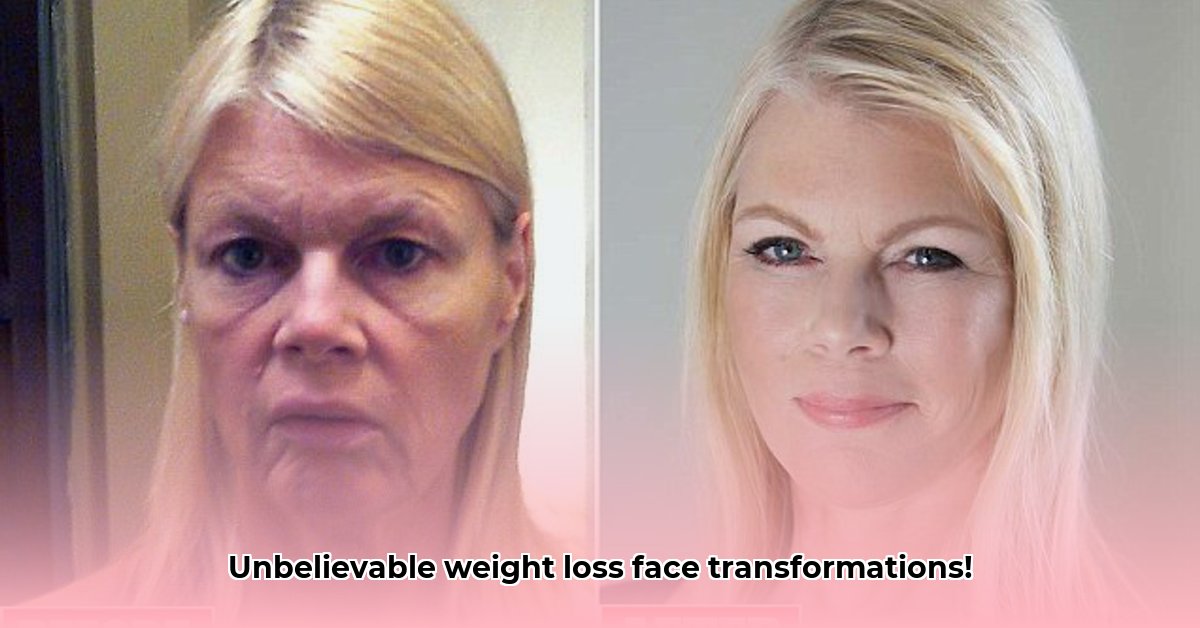
Understanding Facial Changes During Weight Loss
Weight loss dramatically alters facial appearance, going beyond simple weight reduction. It involves fat redistribution, muscle definition changes, and adjustments in skin elasticity. This transformation, often described as a "natural facelift," reveals underlying bone structure and muscle tone as subcutaneous fat diminishes, leading to a more defined jawline, higher cheekbones, and a reduction of a double chin. But the process isn't uniform; individual results vary significantly. Factors like age, the rate of weight loss, and initial weight all influence the final outcome.
The Science Behind the Sculpting Effect
When you lose weight, fat cells shrink, but the fat itself isn't magically removed from specific areas. This redistribution is key to the facial changes observed. The reduction of fatty deposits in the cheeks and jaw results in a more prominent and chiseled appearance, making underlying facial features far more apparent. Simultaneously, improved muscle definition further enhances facial contours. It's a process akin to sculpting, revealing underlying structures previously obscured by fat deposits.
A slow and steady weight loss approach (around 1-2 pounds per week) allows your skin to adapt gradually, minimizing sagging. Conversely, rapid weight loss can lead to skin laxity because the skin hasn't had sufficient time to adjust to the decreased volume.
Age and Skin Elasticity: A Crucial Factor
Age significantly impacts how your face responds to weight loss. Younger skin, possessing greater elasticity, tends to adapt more readily. Older skin, with reduced elasticity, is more prone to sagging and uneven texture after significant weight loss. This difference highlights the importance of a holistic approach incorporating skincare strategies, tailored to individual age and skin type. There are developing areas of research in skincare and treatments to combat this specific issue.
A Holistic Approach: Diet, Exercise, and Skincare
Achieving optimal results requires a comprehensive approach encompassing diet, exercise, and skincare.
Nutrition: A balanced diet rich in fruits, vegetables, and lean protein is crucial for skin health. Sufficient hydration is equally vital, providing the essential building blocks for skin elasticity.
Exercise: While exercise doesn't directly tone facial muscles (the effect is minimal), cardiovascular training helps reduce overall body fat, impacting facial appearance. Strength training, while not directly sculpting the face, contributes to overall muscle definition and body composition improvement, further enhancing the effect of weight loss.
Skincare: A robust skincare routine, potentially including retinoids (under a dermatologist's supervision), assists in maintaining skin health and elasticity. Always consult a dermatologist before introducing new skincare products or treatments. Hydration and sun protection are particularly important, as sun damage exacerbates skin aging.
Potential Risks and Considerations: A Realistic Perspective
While weight loss frequently leads to improved facial aesthetics, it's essential to address potential drawbacks. Rapid weight loss can result in skin sagging, often described as loose or uneven skin. The severity varies depending on factors like the rate of weight loss, initial weight, age, and genetic predisposition. Understanding these potential challenges is key to managing expectations.
Before & After: Real-Life Transformations
(This section will feature a curated series of before-and-after photos of individuals who have experienced noticeable facial changes due to weight loss. Each photo pair would be accompanied by a brief caption detailing their weight-loss journey—the amount of weight lost, duration, methods employed, including details about their diet, exercise regimen and skincare routine, if any.)
Your Action Plan: A Step-by-Step Guide
Achieving successful and healthy weight loss requires a structured approach.
Consult Your Physician: Begin by consulting your doctor. They can assess your health, identify any risks, and recommend tailored strategies.
Develop a Sustainable Plan: Create a realistic and sustainable plan that aligns with your lifestyle. Gradual weight loss (1-2 pounds weekly) minimizes skin laxity.
Prioritize Skincare: Implement a consistent skincare routine, incorporating appropriate moisturizers and sun protection. A dermatologist's guidance is invaluable.
Monitor Progress Regularly: Track your progress and adjust the plan as needed. Don't hesitate to seek assistance from professionals (nutritionists, trainers).
Celebrate Milestones: Regularly acknowledging your achievements keeps you motivated throughout this journey.
Beyond Aesthetics: The Broader Benefits
The improved facial appearance resulting from weight loss is just one aspect of the transformation. The broader benefits encompass increased energy levels, improved sleep, boosted self-esteem, and reduced risks of various health conditions. The visible changes reflect a holistic improvement in health and well-being—the ultimate reward.
How to Prevent Sagging Skin After Significant Weight Loss
Key Takeaways:
- Gradual weight loss is crucial for minimizing skin laxity.
- Strength training improves skin tone and supports underlying tissues.
- A diet rich in collagen-boosting nutrients maintains skin elasticity.
- Sun protection prevents further collagen damage and premature aging.
- Non-invasive procedures may provide additional options following weight loss.
Rhetorical Question: Isn't it empowering to know that you can actively influence how your skin responds to weight loss?
Quantifiable Fact: Studies show that gradual weight loss, maintaining a 1-2 pound per week target, significantly reduces the likelihood of excess skin.
Human Element: Dr. Evelyn Reed, a leading dermatologist at the University of California, San Francisco, emphasizes the importance of consistent sun protection in maintaining skin health throughout weight loss.